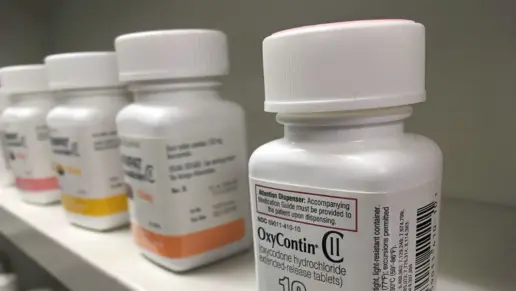Stimulants are substances that speed up brain activity and increase energy and alertness. Legal and illegal stimulants can be misused, leading to stimulant addiction.
This page describes the different types of stimulants, their short- and long-term risks and stimulant withdrawal symptoms. Below, it also covers what stimulant addiction treatment entails including levels of treatment and relapse prevention and what to look for in choosing a treatment program.
Key Facts
- Stimulants speed up brain processes, leading to increased energy, alertness, and attentiveness.
- Amphetamine is a stimulant that is prescribed to treat ADHD and narcolepsy.
- Legal and illegal stimulants have a high potential for misuse that can lead to stimulant use disorder.
- Long-term stimulant misuse can lead to brain changes, psychosis and psychological disorders, cardiovascular risks, and hormone changes.
- No FDA-approved medication is available to treat stimulant addiction; first-line treatments include therapies like CBT, contingency management, and motivational interviewing.
What Are Stimulants?
Stimulants are often known as “uppers” because they make the user more alert, attentive, and energetic. Stimulating substances are used for various reasons including performance enhancement, medical benefits and recreational purposes.
Caffeine is the most commonly used stimulant substance in the world. Other examples are amphetamines, cocaine and prescription drugs used to treat conditions such as attention deficit hyperactivity disorder (ADHD) and sleep disorders.
Illicit Stimulants (Cocaine, Methamphetamine, Bath Salts)
Cocaine exists in powder form and some street names are “coke,” “crack,” and “snow.” Cocaine is often inhaled or dissolved in water and injected intravenously (IV).
- Methamphetamine (meth) is synthetic which means that it is made in a lab. If it’s sold on the street in the form of rocks or crystals then meth can be called “crystal meth” or “ice.”
- Synthetic cathinones are also lab-made to create effects similar to cocaine and meth. They are often called “bath salts” and are snorted, taken orally, smoked or injected intravenously.
Typical stimulant use follows a binge and crash pattern. People use them in large doses over a short period. This causes a “crash” involving depression, hunger and needing to rest for several days. This use pattern causes a short, sudden spike in dopamine levels.
Dopamine is a chemical that is involved in experiencing pleasure so it reinforces stimulant use. Binging causes tolerance quickly, heavier subsequent binges, more drastic crashes and an intense craving for the stimulant.
Prescription Stimulants (Adderall, Ritalin, Vyvanse, Concerta)
Stimulants increase attention and alertness so they are often prescribed for ADHD and narcolepsy. If they’re taken as prescribed for their therapeutic purpose then prescription stimulants can work well in controlling these disorders.
However, some misuse these medications to better focus on schoolwork or weight loss. They, too, can be crushed and snorted or used intravenously.
IV use poses health risks like the transfer of viruses from contaminated needles. Sometimes people engage in diversion by selling, sharing, or trading their prescription stimulants. Others may turn to illicit stimulants when their prescription runs out or is no longer available.
Understanding Stimulant Addiction (Stimulant Use Disorder)
Stimulants are addictive because they cause immediate euphoria and prolonged alertness. This reinforces use and causes cravings.
Why Stimulants Are Addictive
Stimulant use disorder may be present when two or more of the following occur:
- Stimulant is used in larger amounts than intended
- Multiple attempts are made to stop the use
- Continued use despite it causing interpersonal problems
- Continued use despite it contributing to a physical or mental condition
- Repeated use in dangerous situations
- Responsibilities are neglected because of use
- Significant time is spent in acquiring, using, or recovering from the effects of stimulants
- Craving stimulants
- Giving up important activities to use
- Tolerance
- Withdrawal
What Are the Risks of Stimulant Use?
Using prescription or illicit drugs has side effects and is often associated with withdrawal symptoms and risks to a person’s health and well-being. The severity of the side effects can vary depending on several factors including the combination of substances used, route of administration, potency, dosage and level of prior use. The effects can be short or long-term.
Short-Term Effects of Stimulant Use
The following side effects can appear within hours or days and are usually experienced temporarily with controlled use of stimulants:
- Accelerated heart rate
- Vasoconstriction
- Increased blood pressure
- Elevated body temperature
- Panic attacks
- Paranoia
- Hostility
- Fatigue
- Depression
- Changes in appetite leading to weight loss or obesity
- Impaired memory
Long-Term Effects of Using Stimulants
Using stimulants more frequently and in higher doses for a prolonged period can lead to addiction or stimulant use disorder.
There are many long-term health problems related to this type of stimulant abuse including:
Changes to the brain
A stimulant use disorder changes a person’s brain in two major ways. First, it can affect brain functions such as long-term memory and the ability to learn new things. Second, it triggers the addiction process which leads to cravings and ongoing drug use.
Psychosis and psychological disorders
Stimulant use can cause a significant long term change in behavior, a tendency toward violence, paranoia, hallucinations and delusions. It can also worsen the effects of existing mental health conditions such as bipolar disorder.
Cardiovascular risks
Stimulants impact the heart, leading to long term consequences including an elevated risk of strokes and heart attacks. A high body temperature can lead to a risk of hypothermia.
Changes in hormone levels
The effect on hormone levels in the brain can continue long after stimulant use has stopped. For example, suppose stimulants have been used over a long period to cause a release of dopamine. In that case, the brain may not be able to create this neurotransmitter naturally which leaves the user anxious, paranoid and chronically depressed.
Risk of Overdose and Death
It is possible to overdose on stimulants with severe and life threatening consequences. Users of stimulants in excessive quantities risk seizures, fainting, hypertension or even death.
The risk of overdose applies to both prescribed and illegal stimulants. Amphetamines are prescribed to treat ADHD and other conditions but they also have a detrimental impact on public health due to an increase in abuse and hospitalizations.
3x
Between 2008 and 2015, amphetamine-related hospitalizations more than tripled, increasing from 55,447 instances to 206,180.
Methamphetamine (also known as crystal meth) is unsuitable for medical use due to its ability to produce euphoric highs very quickly which is extremely addictive. Crystal meth is particularly dangerous. As of 2019, stimulants and opioids were found to be the leading cause of fatal drug overdose in the US.
Stimulant Withdrawal and Detox
Common Withdrawal Symptoms and Severity
When prolonged stimulant use is suddenly discontinued it can cause:
- Depression
- Fatigue
- Sleep problems
- Increased appetite
- Unusually slow or fast movement
- Intense cravings (a major cause of relapse)
- The most serious potential symptom during withdrawal is suicidal ideation, which can peak from 24 to 72 hours.
Day-by-Day Withdrawal Timeline
The course of withdrawal can vary based on the specific stimulant but generally occurs this way:
First 24 hours
The “crash,” or acute withdrawal, begins.
Within 2 to 7 days
Acute withdrawal continues. Suicidal thoughts may begin in the first one to two weeks.
By Day 3-4
Presence of hypersomnia and appetite surge.
Weeks After
Protracted withdrawal, which lasts for weeks to months, can occur with some stimulants like methamphetamine. This includes depression, fatigue and loss of interest. The severity and duration are often correlated with the severity and duration of use.
Stimulant Detox: Safety, Monitoring, and Suicide Risk
Detoxing from stimulants is generally not medically dangerous and medications are rarely required. At the same time, medical detox which happens under the supervision of providers can be helpful depending on the situation.
Inpatient detox may be needed if the person:
- Has severe depression
- Has psychosis
- Has other substance use disorders
- Is pregnant
Medical detox involves monitoring vital signs, following sleep aid protocols and administering medications like antidepressants.
Managing Acute Psychiatric Complications
Medications may also be used to treat psychiatric complications from stimulant use. For instance benzodiazepines may be prescribed in cases of severe agitation. Antipsychotics may be prescribed for stimulant-induced psychosis.
For cases of suicidal ideation or severe depression, safety planning and connection with medication trials may also be appropriate.
Evidence-Based Treatment Approaches
Your provider may recommend several evidence-based treatments.
Behavioral Therapies: CBT, Contingency Management, Matrix Model
Cognitive-behavioral therapy (CBT) works to identify and change unhelpful thoughts linked to use and develop healthy coping strategies. CBT has been shown to reduce the number of stimulant relapse episodes.
Contingency management (CM) is another evidence-based therapy commonly used for addiction. CM involves providing prizes or vouchers for meeting specific goals like negative urine screens.
The third behavioral therapy is the Matrix Model. It integrates CBT, CM, drug urinalysis and family education into a 16-week manualized format.
This includes individual therapy, skills and social support groups and family education sessions. This helps family members better understand their loved one’s struggle and how to support them.
Motivational Interviewing and Community Reinforcement
Motivational interviewing (MI) is another type of therapy that is often part of addiction treatment. A person with addiction often deals with inner conflicts about use.
They may know that it’s not healthy but the perceived short-term benefits take over. MI helps the person work through these inner conflicts and get them closer to making a healthy change.
The Community Reinforcement Approach (CRA) helps people build a healthy and
pleasurable lifestyle that reinforces recovery. This includes training in problem solving, communication skills (e.g., substance refusal), job skills and building sober social activities. CRA is especially effective in rural settings.
Emerging Pharmacotherapies and Clinical Trials
There are currently no medications approved by the U.S. Food and Drug Administration (FDA) for stimulant use disorder. However, clinical trials are in progress. Topiramate has been shown to be better than placebo at increasing the number of days of cocaine abstinence.
The Accelerated Development of Additive Treatment for Methamphetamine Disorder (ADAPT-2) research program shows that a combination of bupropion and naltrexone has helped more than 13% of participants have three out of four meth negative urine samples.
One study also found mirtazapine to help achieve negative meth urine tests compared to placebo.
Lastly, long-acting injectable psychostimulants like extended-release amphetamine are also being investigated for agonist therapy.
Digital Therapeutics and Telehealth Delivery
Apps can also help facilitate recovery with services like CBT exercises, craving trackers and push notifications. Telehealth with privacy and security platforms has also made treatment more accessible and allowed for flexible scheduling.
Levels of Care for Stimulant Addiction
Inpatient and Residential Rehab
Inpatient or residential rehab involves living at the treatment facility and receiving care and supervision around the clock. Treatment is structured with individual and group therapy, drug education, case management services like vocational rehab and health promoting activities.
Services are provided by a multidisciplinary team consisting of doctors, nurses, psychiatrists, psychologists, case managers and therapists.
28 to 90 Days
A typical inpatient stay lasts 28 to 90 days and is suitable for someone with severe addiction, co-occurring mental health conditions or a home environment that is not supportive of recovery.
Partial Hospitalization and Intensive Outpatient Programs (IOP)
Partial hospitalization programs (PHP) and intensive outpatient (IOP) programs involve living at home while commuting to services. These programs typically involve 20 to 30 hours of services per week.
PHP and IOP programs have comparable outcomes to inpatient rehab at a lower cost. They are also suited for those who have a home environment supportive of recovery or who need to work or attend school while in treatment.
Standard Outpatient Counseling and Tele-IOP
Standard outpatient counseling consists of one to three hours per week of individual or group therapy.
This is often a fit for someone who has a mild addiction or as a step down program after completing a more intensive rehab program. IOP via telehealth is also available where urine testing can be done via mail-in kits to make treatment more accessible.
Aftercare Planning and Step-Down Continuum
Aftercare helps to maintain progress made in rehab and reduce the risk of relapse. There is a rehab step down continuum. Sober living homes are a higher level of aftercare and alumni groups or peer support groups are a lower level of aftercare. Group attendance may decrease in frequency as sobriety continues over time.
Key performance indicators of aftercare include attendance to sessions, consistent employment and negative drug screens.
Featured Facilities Near You
Finding facilities near you…
Integrated and Specialized Programs
There are also integrated and specialized programs that may benefit an individual who needs treatment for stimulants.
Dual Diagnosis (Mental-Health and Stimulant Use)
If someone has a co-occurring disorder which means they have a mental health condition in addition to addiction then treating both concurrently increases chances of positive outcomes.
This is because mental health conditions can lead to substance use and vice versa. Dual diagnosis treatment involves one treatment plan that integrates interventions for addiction and psychiatric conditions. These include both therapy and medication management.
Gender-responsive and LGBTQ+-Affirming Tracks
Examples of challenges faced by this population include intimate partner violence and stress related to discrimination. Having a safe space to discuss LGBTQI+ concerns encourages disclosure and engagement and reduces risk for dropout.
Adolescent and Young Adult Treatment Considerations
Addiction treatment success is more likely for adolescents and young adults when interventions are appropriate to their developmental stage.
For example, retention in these programs can be bolstered by gamified CM. It is also important for this population that treatment incorporates their family and school elements to foster recovery support.
Culturally Tailored/Tribal and Rural Services
Stimulant addiction programs that are tailored to specific cultures address the values and customs of that culture, which helps treatment retention and outcomes.
Such programs may integrate traditional healing practices like sweat lodges and facilitate treatment through the group’s native language. In addition, mobile clinics and telehealth can help overcome the geographic isolation of communities.
Holistic and Complementary Supports
There are also holistic and complementary supports that may help someone affected by stimulant addiction.
Exercise, Sleep, and Nutrition in Neuro-Recovery
Brain health is an important part of recovery because stimulant addiction affects neural functioning which results in mood and circadian rhythm changes.
In addition to cardiovascular health, aerobic activity releases natural endorphins and boosts the brain-derived neurotrophic factor (BDNF). This is a protein that helps with neurotransmitter function.Thus, a high protein and micronutrient-rich diet also helps to repair BDNF function.
Mindfulness, Meditation, and Stress-Management Tools
Mindfulness based stress reduction (MBSR) strategies can help individuals cope with cravings and manage their emotions. Activities like yoga and mindfulness meditation help to dissipate cravings and negative moods. Apps are also available that provide on-demand coping methods when experiencing cravings.
Peer-Led Recovery Groups (NA, SMART Recovery, Recovery Dharma)
Peer-led recovery groups can be important in fostering recovery. Well known peer groups include 12-step groups like Narcotics Anonymous (NA).
Secular groups or those more suited to different philosophies are also available. One is SMART Recovery which stands for Self-Management and Recovery Training. Another is Recovery Dharma which uses Buddhist practices and principles.
Benefits of peer recovery groups include feeling a sense of accountability to others and sharing experiences and coping ideas with those who have the same struggles. Meetings are now often available online to expand access and flexibility.
Family Engagement and the CRAFT Model
Community Reinforcement and Family Training (CRAFT) is a program that trains family members on how to positively reinforce their loved one’s healthy behaviors and encourage them to enter treatment when needed. CRAFT also teaches how to decrease enabling behaviors and improve the family’s overall well-being.
Relapse Prevention and Long-Term Recovery
Identifying Triggers, Cravings, and High-Risk Situations
Recovery is an ongoing process of identifying and dealing with triggers and cravings.
This includes internal cues (e.g., boredom, recalling euphoria) and external cues (e.g., parties, paydays). Keeping a diary of triggers can help control them. Self checks during cravings also help to avoid use.
For instance, the HALT check can be done to see if you are Hungry, Angry, Lonely, or Tired so you can meet those needs appropriately instead of turning to drugs or alcohol.
Contingency Management in Continuing Care
CM can continue during recovery to help prevent relapse. This may include getting drug screens and reporting results to your counselor. Receiving low cost prizes can help maintain abstinence.
Building Recovery Capital: Housing, Employment, Social Networks
Long term recovery also includes fostering a good quality of life. Efforts toward this end depend on your needs and could involve vocational rehab, strengthening protective factors like social support and engaging in activities that give meaning and purpose.
Such elements put together are called recovery capital. The higher your recovery capital score is then the greater chance you have of sustaining remission from stimulant addiction.
Monitoring, Drug Testing, and Recovery-Support Apps
Additional tools to deter relapse include smartphone apps that randomly alert you to submit a saliva sample for drug testing. Apps can also send you CBT prompts to practice skills learned in therapy.
Also, geofencing apps are available that can alert you if you are close to a location that can trigger use.
Choosing a Stimulant Addiction Treatment Program
Accreditation, Licensure, Evidence-Based Track Records
You can check a program’s website for transparency regarding its treatment retention and abstinence rates of participants. You can also look for credentials and licensures of their staff members. The facility itself can also earn accreditation such as CARF or Joint Commission accreditation.
Insurance Verification, Sliding-Scale, and Financing Options
The cost of rehab is also a valid concern. You want to check if they accept your health insurance and if they are in or out of your network.
The Affordable Care Act requires insurance companies to provide some coverage for addiction and mental health treatment. Medicaid and Tricare allow states flexibility in using telehealth and may have coverage for CM interventions. The facility may also offer grants or payment plans.
Questions to Ask Prospective Providers
Other factors that may be important to treatment success include the average caseload of their therapists, how often they do urine drug screens, if they have programs for family members and if they provide alumni support after treatment.
You can also ask if medication assisted treatment (MAT) is available or if they can provide referrals for clinical trials.
Telehealth vs. On-Site: Pros, Cons, and Suitability
Telehealth can yield outcomes similar to in-person treatment for mild to moderate stimulant addiction. See if the facility offers it especially if there are barriers to attending services at the facility. However, with an unstable home environment, severe addiction or comorbidity then inpatient treatment is recommended.
FAQs About Treating Stimulant Addiction
No, stimulant addiction cannot be cured. It is a chronic yet manageable condition. Long term remission is possible. Remission rates improve with good recovery capital and treatment that lasts at least 90 days. Additionally, the brain can recover its plasticity over 12 to 18 months which also supports long-term recovery.
No, there are currently no FDA approved medications to treat stimulant use disorder. CM and CBT are the first line treatments. Several potential medications are in the third phase of their trials. Off label bupropion or mirtazapine are sometimes used for depressive symptoms in withdrawal.
Treatment initially lasts about three to four months. Ongoing monitoring and aftercare services that last 12 months or more are recommended. This helps sustain progress made in treatment and helps to prevent relapse. More time spent in treatment and aftercare can double your chances of sustaining abstinence.
You can help a loved one refuse stimulants in a number of ways like encouraging them to seek professional help, avoiding enabling their behaviors, setting clear boundaries and providing drug-free social interactions. The CRAFT program can help your family develop these skills.
Find Treatment Near You
Rehab.com’s online directory can help you locate stimulant addiction treatment programs in your local area. Enter your location and click “Find Care.” The search results can be filtered by levels of treatment, types of programs, various payment options, specific accreditations, amenities and insurance options.
Not sure where to start? Call the number below for answers to questions, to explore treatment options and to check insurance coverage.
Call A Treatment Provider
For a conversation about what treatment options are available to you.
Make a Call
Stimulant Addiction Treatment and Rehabs Near You
Finding facilities near you…




